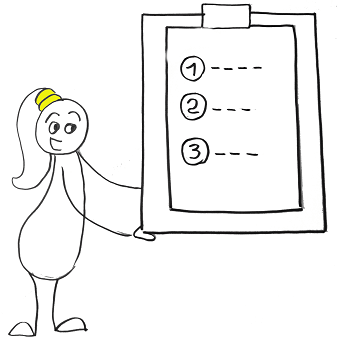Il plurale dei sostantivi
La regola generale per formare il plurale di un nome è aggiungere una -s finale, per invece invece gli altri sostantivi guarda ( e ricorda ) la tabella.
| Regola generale | -s | Teachers |
| Parole terminanti in: -s, -ss, -ch, -sh,-x ,-z , -o. | -es | Classes – matches - foxes |
| Parole terminanti in -o, in -o precedute da vocale e nomi propri terminanti in -o. | -s | Kilos – videos |
| Parole terminanti in y: Precedute da vocale: Precedute da consonante: | -s -ies | Days Cities |
| Alcuni sostantivi in -f -fe | -ves | Halves,knives, leaves,lives,selves |
Per quanto invece i plurali irregolari bisogna studiarli a memoria! Qui puoi trovare una tabella con il plurale dei sostantivi più comuni.
| Irregular List |
| Singular | Plural | Singular | Plural |
| analysis | analyses | appendix | appendices |
| bison | bison | cactus | cacti |
| calf | calves | child | children |
| elf | elves | foot | feet |
| goose | geese | knife | knives |
| leaf | leaves | life | lives |
| loaf | loaves | man | men |
| mouse | mice | person | people |
| scissors | scissors | tooth | teeth |
Countables e Uncountables
i nomi in inglese si dividono in :
- countable nouns ( sostantivi numerabili )
- uncountables nouns ( sostantivi non numerabili )

Countable nouns
che si possono contare:
There are 3 books on the table [tooltip]ci sono 3 libri sul tavolo[/tooltip]
si può mettere un numero davanti
two books [tooltip]due libri[/tooltip]
i countable nouns hanno il plurale
Books [tooltip]libri[/tooltip]
possono avere l’articolo indeterminativo a / an
a book [tooltip]un libro[/tooltip]
quando c'è una domanda viene preceduto da : How many …?
How many oranges should I eat a day? [tooltip]quante arace dovrei mangiare al giorno ?[/tooltip]
uncountables nouns
che non si possono contare.
NO -> two milk [tooltip]due latte[/tooltip]
non si può mettere un numero davanti
NO -> two milk [tooltip]due latte[/tooltip]
two bottles of milk [tooltip]due bottiglie di latte[/tooltip]
Per indicare una parte, quantità di un un countable noun si usano espressioni come…
a drop of milk [tooltip]una goccia di latte[/tooltip]
a slice of cake [tooltip]una fetta di torta[/tooltip]
a litre of milk a day [tooltip]un litro di latte al giorno[/tooltip]
a piece of cake [tooltip]un pezzo di torta[/tooltip]
a bottle of rum [tooltip]una bottiglia di rum- sulla cassa del morto[/tooltip]
a cup of tea [tooltip]una tazza di the[/tooltip]
a bar of chocolate [tooltip]una tavoletta di cioccolato[/tooltip]
a bit of paradise [tooltip]un po ’di paradiso[/tooltip]
a kilo of gold [tooltip]un chilo di oro[/tooltip]
a loaf of bread [tooltip]una pagnotta di pane[/tooltip]
a sheet of paper [tooltip]un foglio di carta[/tooltip]
a bar of iron [tooltip]una barra di ferro[/tooltip]
some milk [tooltip]del latte[/tooltip]
i countable nouns non hanno il plurale
NO -> butters [tooltip]burri[/tooltip]
a roll of butter [tooltip]un rotolo di burro[/tooltip]
non possono avere l’articolo indeterminativo a / an
NO -> a milk [tooltip]un latte[/tooltip]
quando c'è una domanda viene preceduto da : how much …?
how much time have you wasted on facebook ? [tooltip]quanto tempo hai sprecato su facebook?[/tooltip]
Attenzione, qualche uncountable nouns se usato come countable assume un diverso significato.
light (luce) | a light (una lampada)
iron (metallo) | an iron (ferro da stiro)
glass (vetro) | a glass (un bicchiere)
wood (legno) | a wood (un bosco)
paper (carta) | a paper (un giornale)
hair (capelli) | a hair (un pelo)
Plurale in una famiglia
Anche i cognomi formano il plurale quando indica un'intera famiglia. Il plurale segue la regola già viste, tranne che per i cognomi terminanti in -y o in -man, che aggiungono sempre una -s.
The Foxes - The Flahertys
Se al cognome viene aggiunta la parola family esso rimane invariato
The Fox family
--- PER APPROFONDIRE L’ARGOMENTO ---
Understanding the different types of nouns is not very difficult, but it is made daunting because of the seemingly complicated names! Just glancing through this page provides a fast overview of Plural nouns. Remember that Plural nouns are the words used to describe more than one item. Examples of plural nouns are beds, boys, girls, books and cats. They are created by adding a letter 's' to the end of a word or by adding 'es' such as in churches, boxes or witches.
There are some rules when working with English plurals:
Just add an 's' to make most words plural - examples: cats, dogs, girls, bats.
If the noun ends with a ch, s, sh, x, or z add an 'es' to make it plural - examples: churches, boxes, witches, witnesses.
If the noun ends with a letter y and the letter before the y is a consonant change the letter y to a letter i then add es to make it a plural Examples: Sky to Skies & Army to Armies